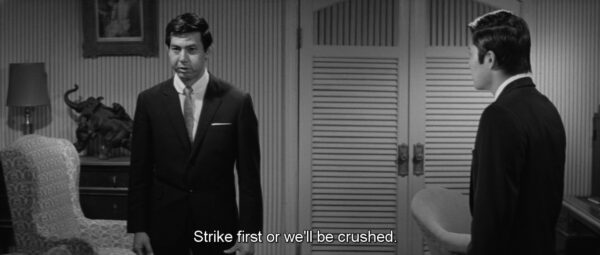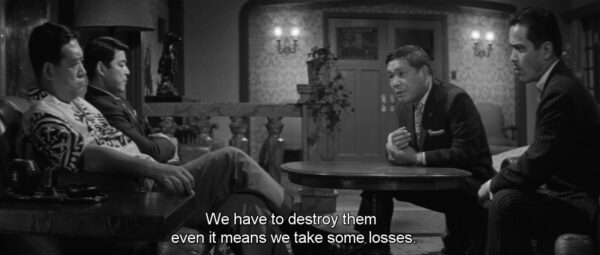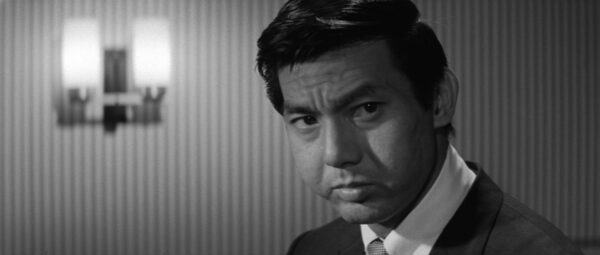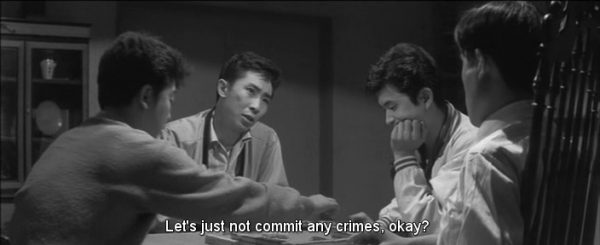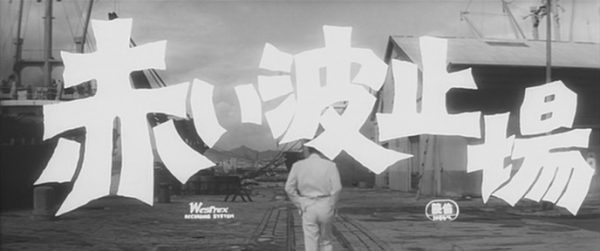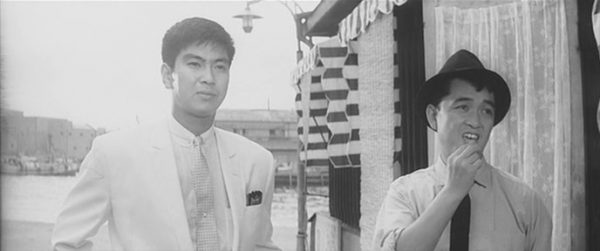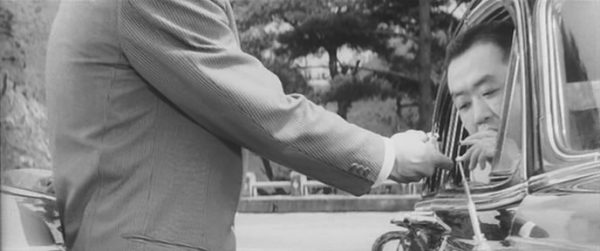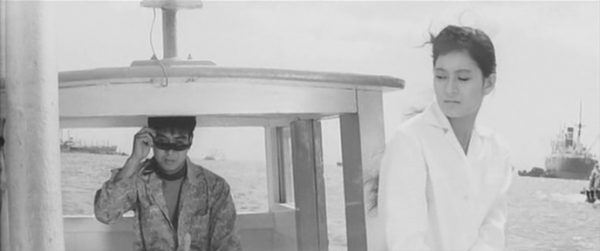
Go! Godman: Godman vs. Stegojiras and Akumon
aka ゴッドマン対ステゴジラス・アクモン その1 – その6 aka Goddoman Tai Sutegojirasu – Akumon

Week of April 5 – 11, 1973
 |
|
Godman’s one weakness — bullets!
|
Stegojiras and Akumon are among the most pathetic designs of the monsters Godman faces. These monsters aren’t even monster suits, just two idiots in slightly oversized masks. One interesting thing is they are more successful than many of the actual monsters at fighting Godman, even though they still lose. Another interesting thing is that they seem to worship an active volcano, and that volcano gives them orders. Just who or what this volcano is, is never explained. Even the accompanying material treats the volcano monster as a mystery. Is this the dark force behind all the other evil monsters Godman fights? Is it just some random underground fire that a couple of brain-dead monsters decided to worship after far too many bong hits? Mysteries forever, that’s what this episode is full of!
Stegojiras has a big blue-green head with giant horns on the top and some other random horns popping out of the bottom. He appears to have big red fish stapled to his shirt, and appears to be slightly more competent than Akumon. Akumon is the red masked monster whose vocals are chicken squawks and he has a gold glitter swastika symbol on his chest, white symbols on his arms. Stegojiras and Akumon vaguely resemble the Chinese legendary creatures With-the-Wind Ear/順風耳/Shunfeng Er and Thousand Miles Eye/千里眼/Qianli Ya, both of whom were seen in The Legend of Mother Goddess and The Ginseng King. Both of them work for some sort of volcano deity mystery monster that lives in the volcano or who knows what, that even the Godman DVD files just refers to as “???”. It is a mystery to never be solved, because no one will ever care to solve it. If you need any other Godman information, be sure to check out the Ike! Godman Splash Page!
Once there were two monster idiots named Stegojiras and Akumon. They worshiped a burning volcano in a forest, which commanded them to steal children. The monsters attempt to steal a young girl from a group of kids at an amusement park, but these monsters are so terrible that one of the teachers accompanying the group chases them down. This teacher manages to hold his own while fighting both of them, despite being an obvious older hippy type who should be more about the free love and peace instead of monster violence. Eventually the teacher is defeated, and the rest of the kids call in Godman after their other teacher asks them to. Hmmm, does that mean only children can call in Godman to fight their battles for them? I guess that’s why Godman is never called upon to do taxes or clean the gutters.
Godman fights Akumon first as we jump to tsuzuku…
The next episode begins with Akumon making chicken noises as he fights Godman. He’s punched out and Godman wakes up the kid, then shoves her away. She yells “Thanks” as she runs, but him shoving her is funny. But the other children are being menaced by Stegojiras, the noise of which distracts Godman enough that Akumon is able to recover and punch him in the back!
Stegojiras and Akumon tie up the female teacher and rekidnap the girl from earlier, taking her to their super sweet ginormous 1970s car. I guess these guys got to wear normal people clothes instead of full costumes because the monster suits couldn’t really fit in the car.
Godman stands in front of their moving car, and as this series doesn’t have the budget to have Godman get hit by the car, the monsters stop and get out of the car again to fight him. The rekidnapped girl escapes again, but…. (Tsuzuku)
Akumon rerekidnaps the girl by punching her in the gut while Godman is busy fighting Stegojiras. Stegojiras pulls out his tiny whip, so out comes Godman’s flail. They fight so hard that a hair gets stuck to the camera for several shots, the action sequences so exciting the cameraman didn’t even look through the camera to see the obvious hair! Godman is then shot in the leg by a drug dart, and Akumon drives away with the girl.
Godman tosses a bunch of explosives at the car that’s speeding away with the innocent girl in it. Luckily for her, he misses the car and she doesn’t die a violent death from being inside an exploding car. Tsuzuku.
We start the next episode with Akumon and Stegojiras arriving at their hidden compound by car and running inside with the kidnapped girl. The car vanishes, because of course it does! Does this mean the car went invisible? Teleported? Never existed? Answers, I hope you like not having them!
The monster hideout is a bunch of creepy abandoned buildings. Godman arrives and looks around the area, only to be ambushed by Akumon! Finally, Godman shows some basic competency and starts to get the upper hand in fighting Akumon, but then Stegojiras points a gun at Godman’s head!
Godman surrenders (!) Except he doesn’t surrender, he pretends to long enough to kick the gun out of Stegojiras’ hand. Godman battles the two monsters some more, until Stegojiras gets his gun again and starts firing at Godman. Luckily for Godman, Stegojiras is worst shots than a Stormtrooper and hits nothing but trees. Tsuzuku.
Godman scares the two monsters off by tossing more explosives. Akumon retaliates by grabbing a Tommy gun and firing it at Godman while Stegojiras drives. Yes, the monsters are doing a drive by on Godman!
They drive to the mysterious Volcano and then Godman shows up so there is more fighting. The monsters rarely remember they have guns in their hands, and when they do, Godman just does a quick tumble to dodge the bullets. Godman rescues the kidnapped girl again, tossing her into a ditch so he’s free to fight the monsters once more. Yes, the hero just threw a small child into a ditch. Tsuzuku.
The monsters fire the Tommy gun at Godman, but that brilliant plan fails when Godman fires bullets back our of his fingers! Godman remembers he has an ultra-strong finishing move, and fires his Godman Supersonic Wave, first at Akumon and then at Stegojiras. At this point, the monsters flip, and then se wee just their masks on the ground, which explode.
So were they monsters, or a fiendish cult straight out of True Detective wearing masks? Mysteries! Godman also defeats the volcano monster by destroying the monsters, as the smoke then goes in the opposite directing, sinking back into the volcano.
The day is saved, Godman returns the now probably traumatized forever child to her teachers and friends and flies away, a hero to those who need heroes named Godman. Which means the kids who need Godman to satiate their bloodlust or enjoy the weirdly sexual wrestling between Godman and the monster of the week.
Akumon and Stegojiras are legit creepy monsters in that they look like they could be your freaky neighbors dressed in ridiculous costumes and kidnapping your child. In this case, the cheapness enhances the scary, because it brings it to a real level.
This was the last series of original Godman shorts. Though some of the monsters would return in Ike! Greenman, Godman himself was not seen again until 2008’s Go Forth! Godman. Which might just get some attention here sooner than later…
Until then, we’re all Godmanned out! Expect these entries to get random updates over the years when I track down different missing pieces and have time to write them up in future Marches of Godzilla. For now, March of Godzilla: Godman has completed its life cycle. You might say we blew up the volcano! But there is always the Godman Splash Page if you want to catch back up with Godman, for some reason.

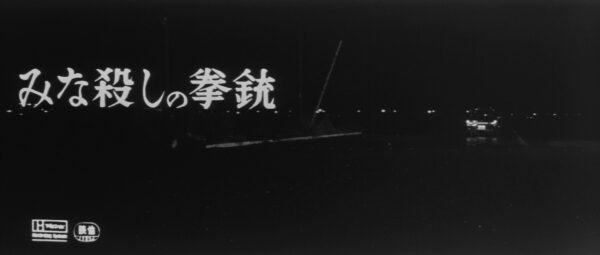
![]()
